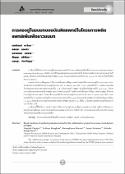Rural retention of medical graduates trained by the collaborative project to increase rural doctors (CPIRD)
นงลักษณ์ พะไกยะ;
ลลิตยา กองคำ;
วรางคณา วรราช;
สัญญา ศรีรัตนะ;
กฤษฎา ว่องวิญญู;
Nonglak Pagaiya;
Lalitaya Kongkam;
Warangkhana Worarat;
Sanya Sriratana;
Krisada Wongwinyou;
Date:
2555-06
Abstract
 | ผลงานวิชาการเหล่านี้เป็นลิขสิทธิ์ของสถาบันวิจัยระบบสาธารณสุข หากมีการนำไปใช้อ้างอิง โปรดอ้างถึงสถาบันวิจัยระบบสาธารณสุข ในฐานะเจ้าของลิขสิทธิ์ตามพระราชบัญญัติสงวนลิขสิทธิ์สำหรับการนำงานวิจัยไปใช้ประโยชน์ในเชิงพาณิชย์ |
Fulltext
Total downloads:
| Today: | 0 |
| This month: | 0 |
| This budget year: | 19 |
| This year: | 114 |
| All: | 1,212 |
Collections
-
Articles [1378]
บทความวิชาการ

